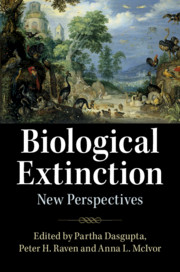Book contents
- Biological Extinction: New Perspectives
- Biological Extinction: New Perspectives
- Copyright page
- Dedication
- Contents
- Figures
- Tables
- Contributors
- Preface
- Acknowledgements
- Introduction
- Prologue
- 1 Extinction in Deep Time
- 2 Biodiversity and Global Change
- 3 The State of the World’s Biodiversity
- 4 Extinction Threats to Life in the Ocean and Opportunities for Their Amelioration
- 5 Out of the Soil
- 6 The Green Revolution and Crop Biodiversity
- 7 Population
- 8 Game Over?
- 9 Why We’re in the Sixth Great Extinction and What It Means to Humanity
- 10 The Consequences of Biodiversity Loss for Human Well-Being
- 11 Terra Incognita
- 12 How Do We Stem Biodiversity Loss?
- 13 Can Smart Villages Help to Stem Biodiversity Loss?
- 14 The New Design Condition
- Index
- Plate Section (PDF Only)
- References
4 - Extinction Threats to Life in the Ocean and Opportunities for Their Amelioration
Published online by Cambridge University Press: 19 August 2019
- Biological Extinction: New Perspectives
- Biological Extinction: New Perspectives
- Copyright page
- Dedication
- Contents
- Figures
- Tables
- Contributors
- Preface
- Acknowledgements
- Introduction
- Prologue
- 1 Extinction in Deep Time
- 2 Biodiversity and Global Change
- 3 The State of the World’s Biodiversity
- 4 Extinction Threats to Life in the Ocean and Opportunities for Their Amelioration
- 5 Out of the Soil
- 6 The Green Revolution and Crop Biodiversity
- 7 Population
- 8 Game Over?
- 9 Why We’re in the Sixth Great Extinction and What It Means to Humanity
- 10 The Consequences of Biodiversity Loss for Human Well-Being
- 11 Terra Incognita
- 12 How Do We Stem Biodiversity Loss?
- 13 Can Smart Villages Help to Stem Biodiversity Loss?
- 14 The New Design Condition
- Index
- Plate Section (PDF Only)
- References
Summary
‘The oceans not only contain most of the planet, but also most of the wide variety of living things’ (Pope Francis, 2015). With this statement, Pope Francis summarised a central point about life on Earth: we cannot understand and protect Earth’s biodiversity without considering the ocean. Covering over 70 per cent of the Earth’s surface, the ocean represents an estimated 99 per cent of its habitable living space (Costanza, 1999). The ocean harbours a remarkably rich diversity of species, with almost twice as many major groups, or phyla, of animals living in the ocean as on land. (Of the 34 known phyla of animals, 33 are found in the ocean and only 12 are found on land.) A single type of marine habitat, the coral reef, holds over 50 per cent more phyla than all terrestrial and freshwater habitats combined, despite having a surface area more than 460 times smaller (Birkeland, 2015).
- Type
- Chapter
- Information
- Biological ExtinctionNew Perspectives, pp. 113 - 137Publisher: Cambridge University PressPrint publication year: 2019
References
- 1
- Cited by



